 Links - some for rainy days
Links - some for rainy days
- First created as a 'place holder' while the Society got under way and began supporting events. All links have been refreshed or removed as several links had become broken (December 2020). More suggestions from Members may be added - let us know.
- The Birdbox Calendar grew over several years until the camera failed. We then developed a calendar as seen by Blue and Great Tits . Timing is based on their behaviour from roosting, fledging and leaving - counted in days (start to finish). Forget the human calendar.
- We take no responsibility for content of other web-sites. Some so-called offers of links to complementary content turned out to be 'harvesting' for only loosely relevant content - so we restrict Link recommendations to Members only.
The Collections
| Church Related Sites | History and Archaeology |
| Family Research | Traditional Measures |
| Names and Languages | Farming & Wildlife |
| The Natural World | Tree Planting and Wilding |
| Neighbourhood Sites - Lynsted, Kingsdown, Kent, Faversham Society and Archaeology | Government Information and Services including - Local Data Sources (tides, weather, train timetables) |
Church Related Sites
- The Creekside Cluster website is the authoritative web presence. An alternative is The Lynsted Local Worship Contacts and Times.
- Canterbury Cathedral Events
- Canterbury Christchurch University College Events: Upcoming events listing
- Lambeth Palace Images on-line (be patient, they have a very slow server)
The Society has developed dedicated pages to: Kingsdown: Church of St Catherine, a rare example of Pugin's Victorian neo-gothic architecture. Built on the site of the mediaeval church (above right).
|
Family Research Sites
One of the first areas of interest for which we had speakers and a topic which continues to be of interest to our Members and visitors.
- Our first speakers came from Tunbridge Wells on 26 May 2004.
- Roper Genealogy Site - Local historic family (we share reciprocal links)
- Sittingbourne Heritage Museum - currently located at 47 East Street, Sittingbourne provides a fascinating entry point into all thing historical for Sittingbourne.
- Public Records Online - If you find a Will of interest, there is a charge to download it (is still cheaper than the train fare to London!). Government Website.
- British Library Site - excellent resources on a wide range of research topics
- Canterbury Cathedral Archives - interesting records that include the Parish Boxes for many parishes in the Diocese.
- University of Kent at Canterbury University Libraries Search
- 'Family History and Research' Directory provides direction to web sites in Kent (and elsewhere) with genealogy in mind.
The Society has developed dedicated pages to: local families - Some ancient, including the Ropers, Hugessons, and many others who form part of our more recent past. World Wars One and Two: From 2010, the Society led detailed biographical research into the names on the Lynsted Church War Memorial for the First World War for the First World War followed by publication of a book of remembrance. The Society also recorded casualties from other Parishes in the Creekside Cluster. We also researched local casualties in WW2 to coincide with the 75th Anniversary of VE and VJ Day, also 80th Anniversary of the Battle of Britain. Both Projects were conducted in partnership with the Imperial War Museum. |
[TOP]
Names and Languages
This page appears here in tribute, initially, to a conversation between David Bage and Lis Heriz-Smith in the Lynsted with Kingsdown Newsletter. Both were sorry to see old favourites fall the the wayside - "hair as straight and pump-water", "it's black over Bills mother's", "rasher of wind", "twitten", are just some.
The Kent Archaeological Society website published a freely downloadable e-book of Kentish dialect (7.62Mb) that is as good a place as any to start! You will find such delights as: marm=a jelly; jawsy=talkative; Gilligaskins=trousers; Polrumptious=rude; wood-noggin=half-timbered houses - and so on.
| Kent on Sunday of 6th February 2005 |
NAMES AND LANGUAGE IN KENT In the 19th century the clerics WF Shaw, vicar of Eastry, and WD Parish, chancellor of Chichester Cathedral, got to grips with 'Kentish', writes Neil Clements. They published their Dictionary of the Kentish Dialect and Provincialisms in Use in the County of Kent in 1888, writing: "The Kentish pronunciation is so much more coarse and broad than that of Sussex, that many words which are common to both dialects can scarcely be recognised a few miles from the border; and many words of ordinary use may become completely altered." Worse still, they found that people in East Kent were prone to making up their own words and deliberately mispronouncing those they didn't approve of, especially words used by "furriners". They were even less impressed by the influence of London on the local dialect, commenting: "The purity of the dialect diminishes in direct proportion to the proximity to London..." "It maybe said that the dialectical sewage of the metropolis finds its way down the river and is deposited on the southern bank of the Thames, as far as the limits of Gravesend Reach, whence it seems to overflow and saturate the neighbouring district." |
On this Site
The Society has not developed dedicated pages to this topic - although we did have a speaker, Dr Paul Cullen in 2005. Read the Report.
[TOP]
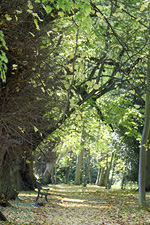 Natural World
Natural World
Grouped under these sub-headings:
- Living Nature
- Natural Phenomena
- Energy Conservation (including Wood-burning advice)
- Dark Skies
- also "Farming and Wildlife" Links Page
Living Nature
- A good treatment of Conservation is the The Conservation Volunteers (TCV) web site. TCV Home Site and BTCV Handbooks (on-line guides that are excellent). Local Parish Tree Warden's are supported by this organisation but if you want to be a Tree Warden - the Tree Council is a good place to start.
- Medway and Swale Estuary Partnership has many resources and images of this region.
- The Kent and Medway Biological Records Centre (KMBRC) is potentially a very important source of data on the natural world in our region.
- Kent Wildlife Trust
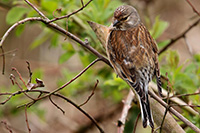 British Trust for Ornithology - a very good resource on long term surveys.
British Trust for Ornithology - a very good resource on long term surveys.- The RSPB Wildlife Gardens initiative runs events and features throughout the year that help gardeners keep in tune with their visitors. Examples: Where have all the birds gone? The water shortage hurts wildlife. Cleaning the areas you feed your birds.
- Find RSPB Reserves in our area include Elmley Marshes (Sheppey), Nor Marsh and Motney Hill (Gillingham), and Blean Woods (toward Canterbury).
 Gardening with Hedgehogs: Two very useful resources:-
Gardening with Hedgehogs: Two very useful resources:-
- British Hedgehog Preservation Society; and
- Hogwatch (a website dedicated to checking whether our hedgehogs are in decline - please take part in their survey saying whether you did).
- Buglife, The Invertebrate Conservation Trust is the first organisation in Europe devoted to the conservation of all invertebrates, and we are actively engaged in saving Britain's rarest bugs, slugs, snails, bees, wasps, ants, spiders, beetles and many more fascinating invertebrates.
- Kent Landscape Information System (K-LIS), lets you zoom into any area of Kent and see what the wildlife habitats, geology and soils, aerial photos and landscapes and much more. A fascinating new resource for all kinds of groups - naturalist, farmers, and so many more. Well worth a visit.
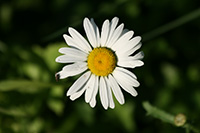 BioImages - Virtual Field-Guide (UK), provides a rich source of images to help you identify plants.
BioImages - Virtual Field-Guide (UK), provides a rich source of images to help you identify plants.- "Carry on Gardening" - Using Gardening to Change Lives. Gardening with the minimum fuss and effort??? Good for your health and sense of wellbeing.
- Royal Horticultural Society - VERY INTERESTING PAGES of monthly plant tips from the experts.
- "Garden Organic" - Reduce the use of chemicals in gardening with informative site.
- Botanical Society of Britain and Ireland (BSBI), is a major resource on our plant life.
- Plantlife - the wild plant charity. Plantlife International is a charity dedicated exclusively to conserving all forms of plant life in their natural habitats, in the UK, Europe and across the world.
- Joint Nature Conservation Committee (JNCC) produces authoritative research on the state of the UK's natural habitat, such as the Vascular Plant Red Data List - (download from their website).
- Kent Bat Group - Find ideas on how we can build up our local population of bats
[TOP]
Native Trees (and Shrubs) in the Kentish Setting
Why is this title so 'specific'? Firstly, "native" means the rest of nature knows how to exploit its presence. Secondly, "Kentish" means suited to the soil, topography, and (evolving) weather systems and temperatures.
- What is that tree? My personal book of choice is the "Collins Tree Guide" and I have tried many. Of course, a second-hand Observer Book of Trees is a good place to start.
- Is there an App for that? Not really - several have tried and failed. If you have a leaf (of any plant) and a mobile phone - give plant.net a go!
- Kent falls into the part of the British Isles that are closest to a desert climate. Climat Change seems set to make our corner even warmer (with intense weather variations between wet and dry). So, when choosing a tree to plant, you are investing in the future. Choice of trees should assume water is going to become even more scarce in most topographies - not marshes (perhaps), and river courses (perhaps)...and so on.
Natural phenomena
- Nature's Calendar Website - part of the Woodland Trust offering - Phenology (Recurring natural phenomena).
- Conservation International (Charity) - a fascinating guide to understanding biodiversity.
- The World Conservation Union (IUCN) is a place to look at the bigger picture.
- European Space Agency searchable database of Images from space.
- NASA's photographs from space - Images of volcanoes, glaciers, hurricanes, and loads more.
- The Met Office - a very comprehensive site that educates.
Energy conservation
- Household Energy Efficiency Reports - now a somewhat dated document - published in 2005: Household energy use accounts for more than a quarter of all energy used in the UK, but the typical household wastes around a third of that energy each year. Read more from the Parliamentary Office of Science and Technology - these are the briefing papers relied on by Parliamentarians.
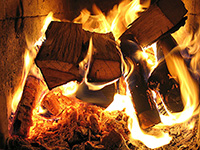 Burning Wood
Burning Wood
Compiled from various sources.
Seasoned Wood. When the Society was formed, the case for properly seasoned timber was based on 'energy returned'. Today (December 2020), the threat of particulate matter pollution has re-emphasised the importance of sourcing wood from well-seasoned stocks or buying and stacking them at home for one or two years if you have the space.
Stove efficiency also matters - DEFRA has listed acceptable models. More about pollution in our Parishes can be found on this dedicated website - AQMA5.co.uk
- Of course, most of us could pile a few logs in a corner of our gardens as a refuge and breeding place for insects. You may be surprised by the variety of insects you will help, and your bird population and visiting hedgehogs will be delighted!
The AIE Firewood Burning Guide - with a few additions
The quality of the following firewood is based upon various characteristics such as its speed of burn, heat given off, tendency to spark (spit), ease of splitting, time required to season, etc
Grade: 1 = Poor. Grade: 2 = Low. Grade: 3 = Good. Grade: 4 = High.
| Common Name | Botanical Name | Comments |
|---|---|---|
| Alder | Alnus | A low quality firewood. Grade: 1 |
| Apple | Malus | Needs to be seasoned well. Burns well with a pleasant smell and without sparking/spitting. Grade: 3 |
| Ash | Fraxinus | Considered to be one of the best woods for firewood. It has a low water content (approx. 50%) and can be split very easily with an axe. It can be burned green but like all wood is best when seasoned. Burns at a steady rate and not too fast. Grade: 4 |
| Beech | Fagus | Beech has a high water content (approx. 90%) so only burns well when seasoned well. Not as good as Oak. Grade: 3 |
| Birch | Betula | Birch is an excellent firewood and will burn unseasoned. However, it does burn very fast so is best mixed with slower burning wood such as Elm or Oak. Grade: 3-4 |
| Cedar | Cedrus | A good firewood which burns well with a pleasant smell. Gives off a good, lasting heat. Doesn't spit too much and small pieces can be burned unseasoned. Grade: 2 |
| Cherry | Prunus | Needs to be seasoned well. Burns well with a pleasant smell and without spitting. Grade: 2-3 |
| Elm | Ulmus | A good firewood but due to its high water content of approximately 140% (more water than wood!) it must be seasoned very well. It may need assistance from another faster burning wood such as Birch to keep it burning well. However it gives off a good, lasting heat and burns very slowly. Dutch Elm Disease is producing a constant & plentiful supply of small dead hedgerow Elm trees of a small diameter. Larger pieces of wood will prove difficult to split. Grade: 2-3 |
| Eucalyptus | Eucalyptus | Allow to season well since the wood is very wet (sappy) when fresh. Can be difficult to split due to stringy wood fibre. Best method is to slice into rings and allow to season during the summer, the rings will start to split themselves. Burns fast with a pleasant smell and without spitting. Grade: 2-3 |
| Hawthorn | Crataegus | Good firewood. Burns well. Grade: 3-4 |
| Hazel | Corylus | Excellent firewood. Allow to season. Burns fast but without spitting. Grade: 4 |
| Holly | Ilex | Can be burnt green. A good firewood. Grade: 3 |
| Hornbeam | Carpinus | Good firewood. Burns well. Grade: 3 |
| Horse Chestnut | Aesculus | A low quality firewood. Grade: 2 |
| Larch | Larix | Needs to be seasoned well. Spits excessively while it burns and forms an oily soot within chimney's. Grade: 1 |
| Lime | Tilia | A low quality firewood. Grade: 2 |
| Oak | Quercus | One of the best firewood's. When seasoned well, it gives off a good, lasting heat. Burns reasonably slowly. Grade: 4 |
| Pear | Pyrus | Needs to be seasoned well. Burns well with a pleasant smell and without spitting. Grade: 3 |
| Pine | Pinus | Needs to be seasoned well. Spits while it burns and forms an oily soot within chimney's. Grade: 1 |
| Plane | Platanus | A usable firewood. Grade: 3 |
| Poplar | Populus | Considered a poorer firewood (see comments below). Grade: 1 |
| Rowan | Sorbus aucuparia | Good firewood. Burns well. Grade: 3 |
| Spruce | Picea | A low quality firewood. Grade: 2 |
| Sweet Chestnut | Castanea | Burns when seasoned but spits continuously and excessively. Not for use on an open fire and make sure wood-burning stoves have a good door catch! Grade: 1-2 |
| Sycamore (Maples) | Acer pseudoplatanus | Good firewood. Burns well. Grade: 3 |
| Walnut | Juglans | A low quality firewood. Grade: 2 |
| Wellingtonia | Sequoiadendron | Poor for use as a firewood. Grade: 1 |
| Willow | Salix | Willow has a high water content so only burns well when seasoned well. Grade: 2 |
| Yew | Taxus | A usable firewood. Grade: 2-3 |
Generally hardwoods are best for open fires because they tend not to spit excessively, however there are exceptions. Conifer wood tends to spit excessively when fresh, so is best used for sealed wood burning stoves, again there are exceptions. Many conifers also cause an oily, sticky 'soot' to form inside the chimney which can increase the risks of chimney fires. Once properly seasoned (see below) conifer wood can be successfully used on the open fire without excessive spitting. Ideally, conifer wood is best mixed with hardwood.
Wood to be seasoned should be cut to length (300mm or 10"-18"), split to size and stacked. The stack should be completely covered on the top to prevent rain wetting the wood but air must be allowed to reach the sides of the stack. Leave to season for at least 1 year (more if possible).
[TOP]
- Energy Saving Trust - Providing expert and impartial advice and information as well as grants to encourage the more efficient use of energy in our homes and vehicles across the UK - Scotland appears to dominate the material.
- Government Pages on Energy and Climate Change: Department for Energy and Climate Change (DECC)
Dark Skies - Light Pollution
It isn't until you reach the truly isolated parts of the UK or wilder and woolier parts of the world that you realise just how hard it is to see our stars at night. Some interesting websites and resources are linked at the end of this page.
The biggest obstacles are:
- Bad weather (no surprise there!)
- Atmospheric pollution (we are all contributing to that)
- Light pollution (domestic security lamps, car lights, buildings, and traffic can contribute road/motorway lights)
Bad weather: Enough said!
Pollution: This is worse when there is high pressure weather system sitting over the UK because the pollution is held down like a blanket over the ground. This is why you can often see a layer of yellow-brown air hanging over towns and cities. London sits in a ‘bowl' so, from Primrose Hill, the view over the Thames can look very dirty - the same happens in San Francisco when pollution is trapped against the surrounding hills. The effects get even worse in hot weather because the chemicals interact with the air. Equally, pollution can result from simple temperature inversion (cold air flowing off mountains over warmer city air that becomes trapped).
From time to time Europe can be the landing place for wind-borne dust and sand that has been whipped up by strong winds over the Sahara Desert in north Africa. A similar effect can be generated locally by ploughed fields or arid landscapes spinning dust high into the atmosphere. It is often the dust in our atmosphere that scatters light and gives us those magnificent red skies at night and in the early morning as sunlight has to travel through more atmosphere at shallow angles at sunrise and sunset. Beautiful, but another indication of pollution that astronomers dislike - beauty is in the eye of the beholder!
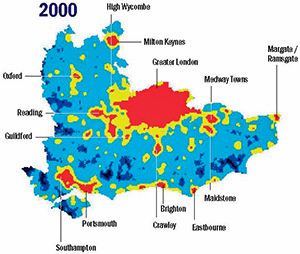 Light Pollution
Light Pollution
- Main roads: We use bright lights along our roads that do four bad things -
firstly, they often shine out sideways and upwards where there are no cars!
secondly, brighter lights encourage faster driving because they give a sense of safety - unless you are a pedestrian or cyclist dodging fast cars;
thirdly, they use very narrow bands of light - these create scenes of deceptively monochromatic light that limit information to the eye (and vegetation); and
finally, these lights are permanently on whether or not there are any cars (or pedestrians) about. This is not going to change fast - but what a waste!
(2013 addendum: locally in Kent we are starting to see lower emission lights in some of our streets) - Car lights: You can't have it both ways. If there is an argument for lower level of permanent lighting along roads, car drivers will want to have the best lights they can on their cars to illuminate the road ahead. Of course, they could slow down so that they don't need to light up longer distances! In built-up areas you are encouraged to dip your headlights. LED lights are no real improvement except in terms of energy consumed.
- Domestic Security lights: Two things we can do as good neighbours and to improve security:
- Firstly, security lights should be shaded and pointed only to the ground - all too often they also point horizontally and upwards. This can be painful for neighbours.
- Secondly, very bright lights create very dark shadows to the eye, making it more difficult to spot things that lower levels of light or several lower wattage lights would reveal. Better still, make sure security lights are activated by passive infra red detectors rather than leave them on all night.
There have been several campaigns over the years and some useful web sites that can help you decide what is right for your own circumstances. Try the following:
- The British Astronomical Association (BAA) suggests counting the stars in December 2006 and January 2007 within the four corner stars of Orion - this can vary between 66 and 2! Orion is seen best in the UK between December and March. However, you can count stars using your own choice of constellation at other times of the year.
- Campaign for Dark Skies web site - this discusses, in a balanced way, the different options for lighting.
- Dedicated UK website ("Dark Sky Discovery") to promoting stargazing and dark skies
- Campaign for Rural England (CPRE) has done some interesting research to reveal how many of us are affected by light pollution.
- Space Imagery: Inspired by Apple Creek's interest in Hubble, I wondered about images of the earth from space and found the following places to browse - Landsat Satellite programme has been giving us images for over forty years! Similar images can be explored from Visible Earth collection (NASA). Both show collections show how difficult it can be to see through our atmosphere! Not just clouds, but volcanoes, dust storms and so on - enjoy!
- Thanks again to Apple Creek student project for this link (2017) to "Home Science" Website that has many projects of educational interest, including astronomy.
- Apps: I have only recently entered the world of "Apps" on smart phones. I have wasted a lot of time exploring the diversity of Apps for different purposes. But care is needed. NOTHING IS FOR FREE - so, a 'free' app is paid for by advertisers who piggy-back on popular app titles and subjects. So, what to do?
- First, "learn the ropes" - a simple guide to 'safe' use of Apps has been produced as a short and readable PDF for you to download from the Information Commissioner's Office. Do read it!
[TOP]
Farming and Wildlife Sites
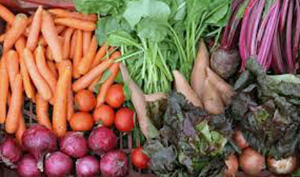 Farming is so often romanticised in modern culture, and yet it is first and foremost an industry. The difference that sometimes obscures this fact is that we either live on "the factory floor" or pass through it regularly. Of course, part of the success of agricultural businesses is tied up with the wildlife that happens to live on the factory floor and scavenges or hunts there. We should not under-estimate how critical the linkages are, nor should we suffer illusions about the importance of how agriculture shapes and manages a very large part off what we call "countryside".
Farming is so often romanticised in modern culture, and yet it is first and foremost an industry. The difference that sometimes obscures this fact is that we either live on "the factory floor" or pass through it regularly. Of course, part of the success of agricultural businesses is tied up with the wildlife that happens to live on the factory floor and scavenges or hunts there. We should not under-estimate how critical the linkages are, nor should we suffer illusions about the importance of how agriculture shapes and manages a very large part off what we call "countryside".
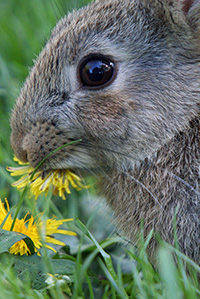 Farmland covers approximately three quarters of the United Kingdom and has historically provided a wide range of habitats for wildlife. Many British species have adapted to living in a farmed landscape. So, efforts to conserve wildlife are often concentrated within managed ecosystems. Much of the wildlife that inhabits farmland has declined over recent decades for a number of reasons, including historic farming methods - use of DDT, 'prairie style' farms without hedgerows, housing and industrial developments with solid fences/barriers, roads, light pollution, atmospheric pollution, climate change, tidy gardens (with solid fence panels - make a hole, you know it makes sense!), removal of ancient woodlands (criminal vandalism by another name), and so on. The reform of the EU Common Agricultural Policy has presented an opportunity for farmers to be rewarded for protecting wildlife. With Brexit, the Government is flirting with the idea of tying grants to improvements in environmental measures.
Farmland covers approximately three quarters of the United Kingdom and has historically provided a wide range of habitats for wildlife. Many British species have adapted to living in a farmed landscape. So, efforts to conserve wildlife are often concentrated within managed ecosystems. Much of the wildlife that inhabits farmland has declined over recent decades for a number of reasons, including historic farming methods - use of DDT, 'prairie style' farms without hedgerows, housing and industrial developments with solid fences/barriers, roads, light pollution, atmospheric pollution, climate change, tidy gardens (with solid fence panels - make a hole, you know it makes sense!), removal of ancient woodlands (criminal vandalism by another name), and so on. The reform of the EU Common Agricultural Policy has presented an opportunity for farmers to be rewarded for protecting wildlife. With Brexit, the Government is flirting with the idea of tying grants to improvements in environmental measures.
Farms have also diversified to attract tourists to the countryside - hop farms, holiday lets, animal experiences, blossom trails, and so on.
- Balancing Nature and Agriculture - The Parliamentary Office of Science and Technology (POST) These Notes give a valuable insight into the briefing of Parliamentarians on key issues. There are 9 Briefs about Farming in December 2020. Worth a browse on this and many other topics.
- POST Notes can be freely browsed and are published on a wide-spread of topics of public importance. They are often informative and are commissioned by MPs to help them understand a wide range of issues.
- Sustainable Farming - Campaign for the Protection of Rural England (CPRE) views on farming in general.
- The Soil Association - since 1946, promoting environmentally friendly use of farmland (and gardens).
- National Farmer's Union - "the voice of British farming".
- Brogdale Collections - "Sustainable Future for the National Fruit Collection" and on our doorstep! Apples, Pears, soft-fruit, and more. Local produce shops on site too.
- Kent Show Ground - lots of events and shows relevant to our countryside and much more.
[TOP]
Neighbourhood
- Lynsted Community Portal web site - originally created to encourage the use of the Internet. Today, most local amenity organisations have their own excellent "shop-fronts". A somewhat diminished site today.
- Lynsted Community Orchard maintains a dedicated web site that is being developed as the project evolves. Events, cherry recipes and a wealth of other material.
- Lynsted with Kingsdown Parish Council web site - minutes, projects, grants, councillor profiles.
- The Faversham Society web site contains rich resources and many instructive events.
- Kent Archeological Society (KAS) - Contains many links to other resources, grants and events.
- CPRE National Intrusion Maps - showing how noise and light have increased since 1960s.
- Borden Heritage web site - does what it says on the tin, and does it very well. Worth a visit.
- Live Rail Information for Teynham - (Updated every two minute for rail services anywhere in the UK).
- South Eastern Trains Information on Teynham/Victoria and Teynham/Cannon Street.
- Local data on:
- tides,
- saving energy - Government Site,
- flood risk map and warning areas
- Help on environmental protection, air quality checks and weather services, solar grants, weather for light aircraft owners? What about holidays in our forests? All in one Government online services website
Government web sites with local angles
- Your Neighbourhood Statistics. You will need your postcode ready to type in - although this link takes you to Swale.
- Central access to all Government on-line services
- The Sites and Monuments Records (SMR) provide considerable historical insights throughout the UK.
- An interesting snapshot of Kent through census data.
[TOP]
Archaeology and History Related Sites
- Kent Historic Environment Records (HER) provide an important place to find listed buildings and archaeologically important sites. From the lower Palaeolithic period (c.450,000 BC) to the present day!
- Kent Archeaology - Archeaologia Cantiana - on-line articles of professional research into Kentish sites and themes
- A thorough and fascinating website about workhouses that includes material on the Faversham area, including the Lynsted workhouse at Bumpit. Also covers Throwley, Selling and Ospringe amongst many others.
- First World War Focus - an outstanding BBC website. Archive film, interactive games, documentary footage, social history at home, you name it. Equivalent BBC pages on World War 2.
- Imperial War Museum - the pre-eminent resources for study of the World Wars.
- School History Website - OK, this is aimed at school exams but don't underestimate its general interest too.
- Pathe Newsreels and images - but you have to pay if you are not a school.
- Twinkl - Astonishingly comprehensive educational resource directed towards child learning.
- British Library's Collection - worth browsing for social history images.
- Choosing museums to visit can be a chore - this site has been relaunched and provides a mine of information and inspiration.
- Schools focused history website (Spartacus) - don't be misled by the title! - includes periods of English history.
- Faversham Society - the senior research group in Swale. Vastly experienced and well-established with a focus on the town and surroundings.
- Historical Research Group of Sittingbourne - a sister group to our own.
- Sittingbourne Heritage Museum - [The website has been down for a long time - January 2014] - currently located at 47 East Street, Sittingbourne - the Museum is still worth considering - but only by phone or walking in at the moment. We will update this link when their website comes on-line.
| Our "historical" content falls under two main headings "Research" (menu bar top, gives you access to all Society Projects) and "Resources" (top-right panel, gives you access to data (e.g. census), documents (e.g. published books and references), images (e.g. postcards), places (information about places in and near our Parish) |
English Weights and Measures (and time)
How many times have you found a reference to an old measure? Here are some for your entertainment. If you know of particular Kentish measures, please let us know. Last updated 2012 - from a book of 1939.
Units of Weight/Mass16 drachms (dr) = 1 ounce (oz) = 28.35g Oddities include:
Troy Weights4 grains = 1 carat Apothecaries' Weight (making up doctors' prescriptions)20 grains = 1 scruple Units of Distance12 inches (in) = 1 foot (ft) = 0.3048m Surveyors used to use7.92 inches = 1 link Cloth and Ribbon Measures:-2¼ inches = 1 nail Cotton, Yarn and Silk Measures1½ yards = 1 thread Other occasional measures of length12 lines = 1 inch Some material, such as canvas, was measured in Ells, 1 ell = 45 inches (1.14m). Nautical Units6 feet = 1 fathom Time, when on a ShipNoon to 4pm = Afternoon Watch Units of Area144 square inches (sq in, in²) = 1 square foot (sq ft, ft²) = 0.092m² Norman measurements of land that were mainly used for tax purposes. The VIRGATE was usually 30 acres of arable land scattered among the common fields of a manor. It varied from as little as 10 acres to as many as 80 in some parts of the country. It was a quarter of a HIDE, and was also known as a 'yardland'. The HIDE was originally land considered sufficient for the maintenance of one family, and therefore roughly what one eight-ox plough team could keep in cultivation. It varied between 120 and 240 acres. The SULUNG appears in the Doomsday Book. 1 sulung = about 160 acres. |
Units of Volume1728 cu inches = 1 cu foot Units of Capacity8 fluid drams = 1 fluid ounce (fl oz) = 0.028 litres 1824 Imperial Standard Gallon:External diameter of the body of the measure, midway between the bottom and the top = 7 29/64 inches. Sizes of barrel63 gallons = 1 hogshead The Firkin of about 8 or 9 gallons and was normally used for butter and cheese. Crops1 bushel of wheat = 60 lbs 27.21 kg Units of Alcohol (in honour of our local pubs and breweries!)Beernip = ¼ pint = 0.142 litres Wine and Spiritstot (whisky) = 1/6 or 1/5 or 1/4 or 1/3 of a gill Champagne2 bottle size 1 magnum Paper Measure24 sheets 1 quire Paper sizes - PrintingDemy 22½ x 17½ in Paper sizes - Writing and Drawing (Weights noted are in pounds of one ream)Emperor 72 x 48 in Paper sizes - Brown PaperCasing 46 x 36 in Book sizesFolio (Fo) Sheet folded into 2 leaves or 4 pages |
Sources:
http://www.doustgenealogy.co.uk/engweights.htm
http://www.sizes.com/materls/paper19eng.htm
http://www.cenius.net/refer/default.php
.... and occasionally from books!
